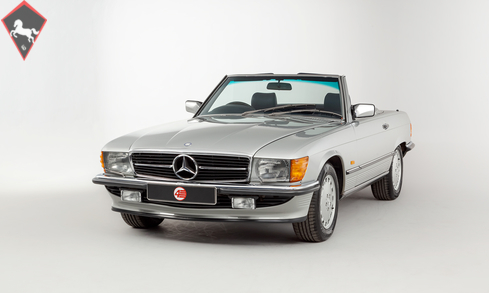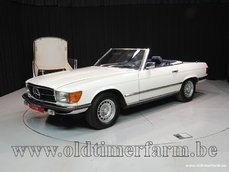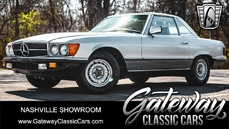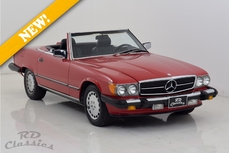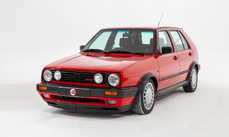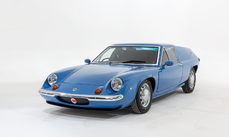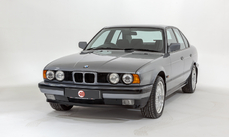Mercedes-Benz 500SL w107 300SL 1989
General description :
Model History
The R107 chassis replaced the sought after W113 SL chassis or “Pagoda” in 1972. The R107 was produced in two variants, the SL and SLC, the SL being a two-seater convertible with a soft-top and removable hardtop.
As one of the second longest chassis series that Mercedes produced there are plenty of engine choices and variants to choose from. The 300SL, as featured here, replaced the 280SL in September 1985. In fact, the real benefit for the R107 was the comprehensive updates that were carried out and fitted to post 1985 cars to bring them up to the then modern standards. These included reworked suspension and anti-roll bars resulting in a more controlled ride; larger four-pot front brake calipers increased the cars braking ability. A limited differential was added and quite a few front-end parts were borrowed from the newly introduced W124 series. The front and rear bumpers were also updated along with a hefty amount of body sheet metal changes, then finished with the new door handles from the W126 series, plus a set of light alloy wheels similar to the W201 chassis.
Equipment
Astral Silver Metallic paintwork, Blue leather upholstery, Dark Blue soft-top, Removable hardtop in Astral Silver Metallic, 15-inch alloy wheels, Heated front seats, Cruise control, Outside temperature indicator, Alarm system, Rear seats, Electric windows, Heat-insulating glass, Headlamp wash/wipe, Blaupunkt Toronto cassette radio, Spare wheel, Spare key.
Exterior
Presented in Astral silver - a fine colour choice for any classic Mercedes - this 300SL is looking particularly elegant beneath our showroom lights. The paintwork presents superbly all round and all panels appear straight with good shut lines. A particularly low mileage R107, this later galvanised example retains a sharp appearance throughout with no signs of corrosion to be found in any of the usual places. All brightwork is in excellent condition.
The blue soft-top makes for a perfect colour combination against the silver paintwork and remains in pristine order, operating exactly as it should. The Astral Silver hardtop also presents impeccably, complementing the overall outstanding condition of the SL.
VIEWINGS WELCOME BY APPOINTMENT ONLY /// ADDITIONAL PHOTOS AVAILABLE UPON REQUEST
Interior
The interior space of the SL completely reflects the low mileage and pampered life this example has led. The blue leather seats both front and rear are in excellent condition, feeling soft and supple with no wear to the upholstery. Having been garaged throughout its life, the interior feels very fresh with no cracks to the dashboard or damage to the delicate wood centre console. Pleasingly the original Blaupunkt Toronto radio is still in place and fully operational, also accompanied by the original instruction booklets. The blue carpet and overmats remain in fine fettle throughout, as does the boot area containing the tool roll, jack, and spare wheel.
ENGINE & TRANSMISSION
The Mercedes 3-litre straight-six engine produces 185hp and propels the SL to 62 mph in a respectable 9.6 seconds. Beneath the bonnet you’ll find a very presentable engine bay. Components and ancillaries maintain a fresh appearance and both inner wings are solid with no corrosion issues to be found. The 4-speed automatic gearbox features sport/economy modes and operates perfectly, feeling smooth pulling through the gears with ease. Most recently the SL has received a full inspection and fresh advisory-free MOT upon arrival at 4 Star.
WHEELS, TYRES & BRAKES
The SL sits on its original 15-hole alloy wheels, all of which – including the centre caps – remain in excellent condition. The wheels are shod in a matching set of Michelin tyres showing plenty of tread remaining. The brakes perform well on test, pulling the car to a stop smoothly and without fuss.
History File
This immaculate 300SL was first registered in August 1989 and was supplied through the Mercedes-Benz dealer Motox Ltd. The SL was initially registered by Motox Ltd prior to being sold to its first keeper, the Rgt Hon Maurice Robson, Managing Partner of Robson Rhodes accountants. It was then sold to its third keeper in 2003 at 9,093 miles before the current owner purchased it in 2006 at 24k miles.
The SL was serviced five times prior to the current owner, who has since had it serviced annually by marque specialists TJ O’Neill. Upon arrival at 4 Star the car was fully inspected and given a fresh advisory-free MOT. The History File is complete with the original Mercedes document pack containing all booklets and manuals as well as a spare key and valet key.
http://www.4starclassics.com/for-sale/mercedes-r107-300sl-for-sale/
1989 Mercedes-Benz 500SL w107 300SL is listed sold on ClassicDigest in Kingsley by 4 Star Classics for £54995.
Car Facts
Car type : Car Make : Mercedes-Benz Model : 500SL w107 Model Version : 300SL Engine size : 3.0 Model Year : 1989 Sub type : Coupé Location : Hampshire
Sold
Seller Information
Sold
People who viewed this Mercedes-Benz 500SL w107 also viewed similar Mercedes-Benz listed at ClassicDigest
Other cars listed for sale by this dealer
About Mercedes-Benz
In the annals of automotive history, the journey of Mercedes-Benz is a tale that unfolds with the ingenuity of its founding pioneers. In the year 1886, Karl Benz crafted the Benz Patent Motorwagen, a creation that would go down in history as the world's inaugural automobile. Unbeknownst to him, this moment marked the genesis of what would evolve into the most illustrious premium car manufacturer globally. The financial underpinning of this pioneering venture, interestingly, was provided by Karl Benz's wife, Bertha Benz, demonstrating a remarkable partnership that would set the tone for Mercedes-Benz's legacy.A parallel narrative emerged not far away, as Daimler-Motoren-Gesellschaft, founded by Gottlieb Daimler and Wilhelm Maybach, entered the scene. In 1901, they unveiled their automobile under the now-famous moniker "Mercedes," meaning "godsend" in Spanish. This name was bestowed upon the car at the behest of Emil Jellinek's daughter, the distributor for Daimler-Motoren-Gesellschaft. The wheels of innovation were set in motion.
Fast forward to 1926, a pivotal year that witnessed the merger of Daimler with Benz & Cie., culminating in the birth of Daimler-Benz. The amalgamation saw the adoption of "Mercedes-Benz" as the distinguished trademark for their automobiles, fusing the legacies of two visionary entities into one.
Contrary to perceptions of conservatism, the trajectory of Daimler-Benz unfolds as a chronicle of industry firsts. From the introduction of the honeycomb radiator to the float carburetor, and the pioneering implementation of four-wheel brakes in 1924, Daimler-Benz consistently pushed the boundaries of automotive innovation. The diesel-powered Mercedes-Benz 260 D in 1936 marked the inception of diesel engines in passenger cars. The iconic Mercedes-Benz 300SL Gullwing made history as the first car with direct fuel injection, albeit the Gutbrod's tiny 2-stroke engine can claim precedence.
Safety innovations became a hallmark, with Béla Barényi's patented safety cell design in the "Ponton"-models in 1951, featuring front and rear crumple zones. The W116 450SEL 6.9 saw the introduction of the Anti-Lock Brake system (ABS), another pioneering safety feature. From the first production airbags and beyond, the legacy of "firsts" continued to be etched into the fabric of Daimler-Benz.
Over its centennial journey, Mercedes-Benz has not merely produced cars but has sculpted automotive icons. The SSKL, 710 SSK Trossi Roadster, 770K Grosser, 540K Spezial Roadster, 300SL Gullwing, w100 600 Pullman, w111 280SE 3.5 Flachkühler, w113 230SL Pagoda, w109 300 SEL 6.3, and w201 2.3-16 Cosworth stand testament to the brand's commitment to engineering excellence.
The roaring Silver Arrows, or "Silberpfeile," including the W 25, W 125, W154, W165, and W196, created a legacy of dominance on the racetrack. These machines were not merely cars; they were expressions of precision, speed, and an indomitable spirit that left their competitors in the dust.
As Mercedes-Benz marches into the future, it does so not just as an automaker but as a custodian of a legacy, a torchbearer of innovation, and a beacon of automotive excellence. The road ahead is sure to witness the continued fusion of cutting-edge technology, timeless design, and an unwavering commitment to setting new standards in the world of automobiles.
One luminary figure who left an indelible mark was Béla Barényi, often heralded as the "father of passive safety" for his pioneering work in safety engineering. His patented safety cell design, featuring front and rear crumple zones, became a hallmark of Mercedes-Benz's commitment to occupant safety, setting new standards that reverberated throughout the automotive world.
Moving through the chronicles, the collaborative genius of Wilhelm Maybach, alongside Gottlieb Daimler, laid the foundation for Daimler-Motoren-Gesellschaft. Their innovations not only birthed the first Mercedes but established a culture of relentless pursuit of technological excellence that remains integral to Mercedes-Benz's DNA.
In the post-merger era of 1926, Ferdinand Porsche emerged as a prominent figure within Mercedes-Benz. His work on the Mercedes-Benz S-Type, a supercharged race car, garnered acclaim and set the stage for a legacy that extended far beyond the marque. Porsche's impact would later extend to his eponymous company, but his influence at Mercedes-Benz during those formative years was pivotal.
As the 20th century progressed, the legendary Rudolf Uhlenhaut emerged as a key figure. Uhlenhaut, an accomplished engineer and the driving force behind the iconic Silver Arrows, played a crucial role in Mercedes-Benz's dominance in motorsports. His engineering prowess and attention to detail were instrumental in creating some of the most formidable racing cars of the era.
In the latter half of the century, figures like Bruno Sacco, the head of design at Mercedes-Benz from 1975 to 1999, left an indelible imprint on the brand's aesthetic identity. Sacco's design philosophy, characterized by clean lines and timeless elegance, shaped iconic models like the W126 S-Class and the W201 190E, solidifying Mercedes-Benz's reputation for luxury and sophistication.
The narrative would be incomplete without acknowledging the contributions of engineers like Hans Scherenberg, whose leadership in the 1970s ushered in a new era of technological innovation at Mercedes-Benz. Scherenberg's tenure saw the development of groundbreaking technologies, including the Anti-Lock Brake system (ABS) and the introduction of airbags in production cars.
